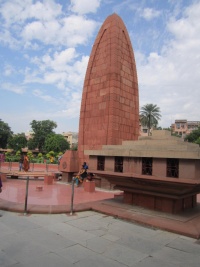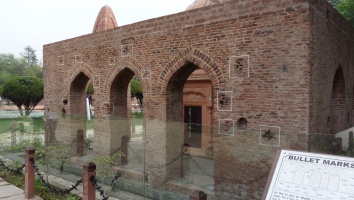Understanding the Amritsar Massacre↑
A. – I opened fire.
Q. – At once?
A. – Immediately. I had thought about the matter and don’t imagine it took me more than 30 seconds to make up my mind as to what my duty was.[1]The questions were from Lord William Hunter (1865-1957), a former Liberal Member of Parliament and Solicitor-General of Scotland, tasked from 1919 to convene a Court of Inquiry investigating the “Punjab disturbances” of that year.[2] The respondent was Brigadier-General Reginald Dyer (1864-1927). Dyer had been mentioned in dispatches and made a Companion of the Order of the Bath for his heroic First World War service. He had commanded the Seistan Force of the Indian army in Eastern Persia (Iran) and was tasked with preventing German and Ottoman infiltration into Afghanistan. His celebrated methods involved “retributive actions” against the hostile populace, including starving uncooperative “tribes” by seizing their livestock and burning their villages.[3] His less-than-celebrated actions in Punjab involved firing 1,650 rounds into a peaceful crowd of up to 20,000 religious pilgrims and political protestors assembled in a large square (the Jallianwala Bagh) in the middle of Amritsar.[4] He then forbade anyone to attend to the scene for two days even as the corpses and wounded lay rotting in the summer sun:
Contesting Memory↑
The precise details of the massacre were and remain contested.[6] The Hunter Commission claimed a death-toll of 379 after fifty soldiers fired their rifles for approximately ten minutes.[7] There was also an attempt to justify Dyer’s reasoning, if not his actions, by discussing at length the near-violent disorders by “mobs” in Amritsar in the days and weeks before the massacre on the 13 April 1919.[8] The Indian National Congress in a parallel inquiry led by Mahatma Gandhi (1869-1948) and Chittaranjan Das (1869-1925), and involving Jawaharlal Nehru (1889-1964), claimed the number of the dead was closer to 1,500.[9] There were also attempts to justify the violence that had preceded 13 April by placing it in the context of agitation against the Rowlatt Acts – the extension into perpetuity in British India of emergency wartime measures that suspended ordinary jurisprudence, freedom of assembly and freedom of the press – and previous firings on crowds by the police on 10 April.[10]
The precise details were disputed by the British and anti-colonial nationalists, but the ever-present nature of spectacular displays of colonial violence were not. Dyer’s reputation depended on his previous expertise in colonial counter-insurgency, and Punjab was seen at the time – especially by Sir Michael O’Dwyer (1864-1940), the Lieutenant-Governor of the province – as requiring extraordinary, performative repression because of the revolutionary conspiracies that haunted the British Imperial imagination in India during the First World War.[11] Other forms of violence, from the aerial bombardment of Gujranwala to public floggings in the streets of Amritsar,[12] were not met with the same condemnation as the massacre itself. Even for the Indian National Congress, it was not merely the massacre that constituted the “Punjab Wrong” but the failure to prosecute or condemn Dyer even though the evidence of wrong-doing was overwhelming (Dyer was retired on half-pay and a retirement fund was raised to celebrate his actions by the British press[13]). As Gandhi put it in an editorial in his newspaper Young India in the aftermath of the Jallianwala Bagh Massacre, “No government deserves respect which holds cheap the liberty of its subjects.”[14] Within months Gandhi was directing the Non-Cooperation - Khilafat Movement – the first all-India push for independence.
Gajendra Singh, University of Exeter
Section Editor: Heike Liebau
Notes
- ↑ Report of the Commissioners Appointed by the Punjab Sub-Committee of the Indian National Congress, 25 March 1920, [Report by the Congress Sub-Committee], Lahore 1920, p. 56.
- ↑ Report of the Committee Appointed by the Government of India to Investigate Disturbances in the Punjab etc. [Report of the Hunter Commission], Parliamentary Papers, 1920, Cmd. 681.
- ↑ The London Gazette, 31 October, 1917.
- ↑ The number of rounds fired is known but the precise numbers of people in the Bagh at the time is not. Different estimates can be found in the Report of the Hunter Commission and in the parallel Congress inquiry.
- ↑ Statement by Lala Girdhari Lal; Report by the Congress Sub-Committee, pp. 56-57.
- ↑ The most recent examples being Lloyd, Nick: The Amritsar Massacre: The Untold Story of One Fateful Day, London 2011, which is an under-researched polemic in defence of Dyer; see the review by Kim Wagner for Reviews in History, online source: http://www.history.ac.uk/reviews/review/1224 (retrieved 11 May 2016). Another example is the excellent Sherman, Taylor: State Violence and Punishment in India, London 2010.
- ↑ Report of the Hunter Commission.
- ↑ Ibid.
- ↑ “An Appeal from Punjab,” Young India, 2 August 1919; The Collected Works of Mahatma Gandhi, Vol. 18, 1 May 1919-28 September 1919, New Delhi 2000.
- ↑ Report by the Congress Sub-Committee, Chapters 2-4.
- ↑ Cf. Singh, Gajendra: “India and the Great War: Colonial Fantasies, Anxieties and Discontent,” in: Studies in Ethnicity and Nationalism 14/2 (2014).
- ↑ Mentioned at some length in the Report of the Hunter Commission but abbreviated in the Report by the Congress Sub-Committee.
- ↑ A sum of £26,000 raised through a fund established by The Morning Post.
- ↑ “A Punjab Victim,” Young India, 15 October 1919; The Collected Works of Mahatma Gandhi, Vol. 19, 29 September 1919 – 24 March 1920, New Delhi 2000.
Selected Bibliography
- Coates, Tim (ed.): The Amritsar massacre. General Dyer in the Punjab, 1919, London 2000: The Stationery Office.
- Datta, V. N.: Jallianwala Bagh, Kurukshetra 1969: Lyall Book Depot.
- Draper, Alfred: The Amritsar massacre. Twilight of the Raj, London 1985: Buchan & Enright.
- Fein, Helen: Imperial crime and punishment. The massacre at Jallianwala Bagh and British judgment, 1919-1920, Honolulu 1977: University Press of Hawaii.
- Kolsky, Elizabeth: Colonial justice in British India. White violence and the rule of law, Cambridge 2010: Cambridge University Press.
- Lloyd, Nick: The Amritsar massacre. The untold story of one fateful day, London; New York 2011: I. B. Tauris.
- Sayer, Derek: British reaction to the Amritsar massacre 1919–1920, in: Past and Present 131/1, 1991, pp. 130-164.
- Sherman, Taylor C.: State violence and punishment in India, London; New York 2010: Routledge.
- Singh, Gajendra: India and the Great War. Colonial fantasies, anxieties and discontent, in: Studies in Ethnicity and Nationalism 14/2, 2014, pp. 343-361.
- Swinson, Arthur: Six minutes to sunset. The story of General Dyer and the Amritsar affair, London 1964: Peter Davies.
- Tuteja, K. L.: Jallianwala Bagh. A critical juncture in the Indian national movement, in: Social Scientist 25/1-2, 1997, pp. 25-61.









